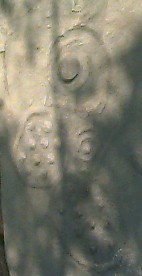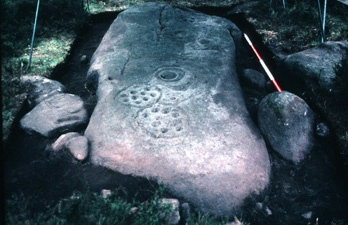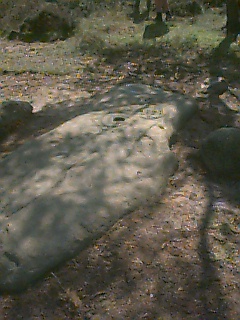

Several examples of "rock art" are known from Gardom's Edge. A stone bearing cup and ring marks was discovered during an early excavation of a large cairn. This can now be seen in Sheffield City Museum in Weston Park. A second stone with cup and ring marks remains on the moor. The most remarkable example was identified by a team led by Leslie Butcher in the early 1960's. The design consists of a series of cup and ring marks together with a small "spiral" and two circles that enclose multiple cup marks. These were carved on a large earthfast boulder situated on a natural lynchet that follows the line of a periglacial feature.

The dating and interpretation of rock carvings is fraught with problems. The current consensus is that many date to the later Neolithic or Early Bronze Age. Dating has been based upon associations with cultural material found in the vicinity and on parallels with designs in other media (e.g. on pottery). In a few cases, chronology has been inferred where stones with existing carvings were broken up and re-used in features such as cairns that have more reliable dates. However, this only dates the timing of re-use and not the actual carving of the rock itself.

Despite many competing interpretations, we do not know what significance was attached to the carvings or to the act of carving during prehistory. However, the landcape setting of many carvings does provide a few clues. Recent research suggests that many are associated with the fringes of uplands and with important paths of access between lower and higher ground. On occasion, they seem to line the route towards important monument complexes. This is by no means a black and white pattern, but the tendency for carvings to be located in this way suggests that some at least were in places that were visited from time to time by people on the move. Often difficult to find (in places that had to be revealed and remembered), carving sites nonetheless afforded a particular vantage over the surrounding land.
What the designs may have meant is still open to question. It is quite possible that they had many meanings, depending on your age, gender, kinship or initiation. Meanings may have also changed over time. In many small scale societies, the carving and/or painting of rocks is an act that can be associated with the renewal of spiritual or ancestral connections between people and land. It may be useful to think in similar terms. Perhaps the carvings at Gardom's were produced and returned to by generations of herders and hunters who passed this way as part of their seasonal round.
In 1996, a trench was excavated to investigate whether prehistoric activity around the rock art boulder involved the deposition of material or the cutting of features in close proximity. The trench was virtually devoid of any archaeological features or artefacts, apart from the rock art itself. Two stakeholes were the only features. Apart from part of a polished shale ring with an unfinished perforation created after breakage, the only other finds were a small number of chert and flint flakes.